[Retracted] Analysis and Application of Crosscultural Knowledge System Structure in English Teaching Based on Hierarchical Correlation Analysis
Abstract
With the prosperity of the economy, China’s foreign exchanges are becoming more and more frequent, and English is becoming more and more important as the common language of international communication. For decades, Chinese educators and scholars have achieved great success in teaching English, but there are also some problems, including neglecting the teaching of crosscultural knowledge in English classrooms. And in the crosscultural English teaching based on hierarchical correlation analysis, its specific structure system is not complete, and its application scope is also less. Therefore, this paper analyzes hierarchical correlation analysis, teaching mode, etc., which lays the foundation for subsequent research. In addition, combined with the current research status, this paper analyzes the past crosscultural knowledge system and proposes a new structural model. A large number of experiments have verified the application effect of the improved knowledge architecture model in crosscultural English teaching under the hierarchical correlation analysis. The new model can improve students’ crosscultural awareness and crosscultural communication competence and improve the previous teaching system structure. There is a problem that both hierarchical teaching and overall planning cannot be taken into account. This paper studies the crosscultural issues in English teaching and conducts research from the following four aspects: first, it discusses the cultivation of crosscultural communicative competence of college students in English teaching and proposes some feasible solutions to the problem of neglecting the integration of crosscultural knowledge in English teaching. Sexual suggestions cultivate students’ crosscultural awareness of English learning and improve the efficiency of English learning. The second is to point out that college school students should pay attention to the differences in cultural communication between China and foreign countries and develop the awareness and ability of crosscultural communication. The third is to explore ways to improve students’ crosscultural communicative competence and cultivate all-round English talents for the country and society. The fourth is how to achieve crosscultural communication, so that people with different cultural backgrounds can communicate and learn smoothly. Based on the above problems, this paper adopts the method of case analysis to discuss the problem of imperfect cross-cultural knowledge system in English teaching in China, and the educational structure is incomplete.
1. Introduction
This paper proposes a detection-based three-level hierarchical association method, which is applied to the study of thought reflection of people’s cognitive process, and is evaluated on two datasets, cognitive and expressive. Experimental results show that the performance is greatly improved compared to previous methods [1]. We propose a hierarchical association method and train a key trajectory association model with the stimulus algorithm. This method uses a soft max function to relax the overtarget function of traditional instance ranking methods, which provides a tighter upper bound on the empirical error for distinguishing correct and incorrect associations, thereby providing a more accurate trajectory association model for trajectory association problems [2]. This paper proposes a data-oriented data association algorithm that relies on the Hungarian algorithm for the association step, which also treats detection responses below the detection threshold as evidence associated with high ambiguity [3]. This paper introduces the problem of data mining association rules. We use an iterative approach to gradually increase the size of the itemset and describe the hierarchical algorithm in detail. Finally, an improved algorithm is proposed, which combines the last few iterations and scans the database at a time [4]. In this paper, a system-coupled hierarchical data association scheme is proposed, and a novel teaching model based on depth-invariant parts using RGB-D data is proposed. Our method is verified from several aspects, such as system coupling feature selection scheme, hierarchical data association scheme, and various RGB-D-based modeling schemes for teaching systems, proving its effectiveness and efficiency [5]. Bayesian networks (BN) use probability distributions to build models with the benefits of providing decision-making in complex domains, smooth, consistent, and flexible applicability and association rules based on antecedents and consequences with conditional and decision properties, respectively. We focus on association rules to develop automated data mining techniques, using the association rule binary symmetric matrix of the K2 (ARBSM-K2) technique to generate hierarchical association rules that exhibit more determinism in the hierarchy [6]. This paper shows how this problem can be addressed through corpus-based research, conducted through a study of the idioms most commonly used by students in spoken American English, which includes a close alignment of the idioms used in three contemporary corpora of spoken American English. A search and analysis revealed interesting patterns of English idiom usage [7]. This study investigated mainland Chinese parents’ perceptions of their children’s participation in English language learning programs outside the classroom. The hypothesis that Chinese parents prefer Westerners to be their children’s English teachers has also been tested. The analysis of student perceptions of ELT and the structure of educational institutions in ELT under a cross-cultural system can provide many opportunities for future research in this field [8]. This paper studies college English teachers’ decision to adapt teaching materials to adapt to learners’ differences. The main purpose of this study is to conduct a descriptive and analytical study of teachers’ decisions on the adaptation of English textbooks. This paper begins by describing a review of the college curriculum and English textbooks, analyzing the incremental decision-making model of the curriculum decision-making process and key elements of decision-making, and discussing the relationship between the different levels and elements of future teacher professional development [9]. Through a comprehensive literature review of knowledge management and intercultural competency research, seven thematic competencies of knowledge assimilation were identified. This paper provides a model to improve the crosscultural knowledge architecture to make it more complete [10]. The purpose of this paper is to focus on crosscultural impression management as part of acculturation, examining knowledge gaps by identifying differences between host country norms and domestic cultural norms. These findings tell us about how acculturation begins and are an in-depth qualitative study [11]. This article explores the role of leadership in crosscultural knowledge management (CCKM) and discusses the existing literature on leadership and crosscultural leadership and the relationship between leadership and knowledge management to illustrate the different domains of leadership role in. In order to emphasize the influence of leadership on CCKM, the influence of leadership on different factors in the theoretical model of CCKM was studied, and a multicultural management system was established [12]. This article focuses on the need for intercultural knowledge of people working and living in today’s world, recognizing that cultural differences can lead to better employment opportunities. This article describes the benefits of working in multidisciplinary area groups to promote foreign language teaching. The authors highlight the importance of university education in changing and developing mindsets as a long-term way of ensuring stronger education systems [13]. This article discusses end-to-end (ETE) data analysis tools used by educational researchers such as data mining, culminating in the hierarchical knowledge management model (TKMM), which aims to provide a stable structure for organizing a large number of established and nascent technologies, revealing patterns and relationships in data through a high-performance data modeling process, and providing researchers with richer and more unified analytical tools [14]. Starting from the characteristics of English subject, this paper establishes an English model of knowledge structure, analyzes the English knowledge structure of college students, explores the characteristics of students’ growth and the differences in the main influencing factors, and finds out the thinking and cognitive development system of college students’ English comprehension: an effective way to explore English comprehension [15].
2. Association Function and Crosscultural Knowledge System
2.1. Association Function
2.2. Determine the Association Degree
2.3. Crosscultural Definition
Crosscultural refers to a cultural phenomenon that conflicts with national culture. From the perspective of cultural theory, cultural identity refers to the belonging and acceptance of a group or individual to a specific culture and has a specific cultural value orientation. The so-called “cross-culture” refers to the culture across different national boundaries, which is the interaction between many groups of different cultural backgrounds. In short, “interculture” is the interaction between all people who experience cultural connections through crossing system boundaries and is societies with increased social mobility and racial mixing in globalization. Tradition and the existing culture were combined to create a new culture.
2.4. Construction of Knowledge System
The knowledge system is not a single item of knowledge but a closed loop that a different knowledge content affects each other in a special way and can be used at any time. After the establishment, it is necessary to continuously expand and improve and gradually cultivate from a few saplings into a large forest. The establishment of the knowledge system is a lifelong teacher, and learners must master the ability. However, China’s English education overemphasizes the teaching of language skills. Without a complete education system, it is impossible to teach both language skills and compare cultural differences in English classes. In the process of learning English, students can only master vocabulary, sentence forms, grammar, and other language forms, and it is difficult to carry out appropriate and effective crosscultural communication, which undoubtedly deviates from the ultimate goal of English learning. Therefore, English teachers should not only teach English level but also pay attention to improving students’ crosscultural awareness. To promote students’ crosscultural communication consciousness through college English teaching, it is necessary to organically combine the development of language function and ability with the improvement of cultural literacy and establish a comprehensive English education system with crossculture as the core. It is more necessary to optimize the curriculum system, clarify the teaching concept, and use the teaching methods for the purpose of enhancing the awareness of cultural comparison, so as to realize the tasks and goals of advanced English teacher in the new era.
3. Hierarchical Association Analysis
3.1. Association Rules under Teaching
3.2. Basic Steps of the Association Analysis
- (a)
Clarify the assessment purpose, define the index scoring system, collect the index data, determine the data order, and form the formula (7)
(7)where m is the number of indicators Xi = (xi(1), xi(2), ⋯, xi(m)), i = 0, 1, ⋯, n. If the k-th index in the data is the reverse indicator and recorded as xi(k), the reverse indicator must be turned forward as formula (8). Some are indicators that the larger the index value is, the better the evaluation is and are called positive indicators (also known as benefit-type indicators or large-scale indicators, cost-type indicators or small-scale indicators), and some indicators whose value is closer to a certain value, the better, are called moderate indicators. In the comprehensive evaluation, the index must be the same trend first, and generally, the reverse index is converted into a positive index; so, it is also called the forwardization of the reverse index.(8) - (b)
Determine the reference data column X0, that is, to determine the ideal comparative model according to the purpose of the evaluation (note to formula (9))
(9) - (c)
The index data sequence is preprocessed, such as formula (10)
(10) - (d)
Calculate the absolute difference between the corresponding elements of each index sequence and the reference sequence, as shown in formula (11):
(11) - (e)
Determine between and
- (f)
The correlation coefficient is calculated separately for the corresponding element of each comparison sequence and the reference sequence, as shown in formula (12):
(12) -
ρ is the resolution coefficient, taking the value within (0, 1), and the smaller ρ, the greater the difference between the correlation coefficients, and the stronger the distinguishing ability.
- (g)
According to the different importance of each index in the total score, calculate the correlation degree, assign appropriate weights to each index, and calculate the weighted average of the correlation coefficient:
(13)where Wk is the weight of each indicator. - (h)
According to the correlation degree of the observed objects, a comprehensive evaluation result is obtained
3.3. Establish a Hierarchical Structure Model
If the elements of structure A are transitional, i.e., satisfy aikakj = aij, then A is said to be a consistent structure.
3.4. Conformance Inspection
3.5. The Application of the Hierarchical Association Analysis
In addition, the smaller |(x0(k) − x0(k)| is and the larger r(Xi, Xj) ≠ r(Xj, Xi) is in the proximity, then r(X0, Xi) is called the degree of correlation between Xi and X0. r(x0(k), xi(k)) is the correlation coefficient between H and Xi at point X0. Completeness reflects the influence of the system on the comparison of correlations, which vary from system to system. Therefore, the principle of symmetry is not necessarily satisfied. Pairwise symmetry means that when there are only two sets in the set of correlation factors, the pairwise comparison satisfies the symmetry. Proximity, on the other hand, is a constraint to quantify relatedness. The general hierarchical structure diagram is divided into three layers, of which the highest layer is the goal or ideal result of the problem decision at the target layer, and there is only one element. The middle layer is the criterion layer, which includes all the factors involved in the intermediate links in order to achieve the goal, and each factor is a criterion. The lowest layer is the program layer. The program layer is a variety of measures to choose from to achieve the goal, that is, the decision-making program. Generally speaking, some factors between different levels are related, and some are not necessarily related. The number of factors at each level may not necessarily be the same. In practice, it is determined according to the nature of the problem and the categories of relevant factors.
4. An Empirical Study on the Application of Intercultural Knowledge in English Teaching
4.1. Data Acquisition
Under the guidance and assistance of relevant experts, this study determines the following specific observation aspects: the teaching and development of crosscultural knowledge, the cultivation of crosscultural communication attitude, etc. The nonparticipatory observation method is adopted to understand the state of students’ multicultural knowledge in classroom teaching without interfering with teachers’ teaching activities and students’ normal learning. This paper adopts a questionnaire survey, which consists of three dimensions: crosscultural knowledge teaching, cultivating crosscultural communication attitude, and crosscultural communication development ability. In order to deeply understand the actual situation of crosscultural knowledge training of College English teachers and students, this study is conducted from three aspects: teaching intercultural knowledge, cultivating crosscultural communication attitude, and cultivating intercultural communication attitude. Explore and analyze in English teaching to find out the problems existing in the cultivation. The sample questionnaire was selected from three colleges in J City, Hunan Province. Each college issued 100 votes to students, issued a total of 300 votes, and recovered 285 valid votes, with a valid recovery rate of 95%. The detailed sample distribution of the survey subjects is shown in Table 1.
| Title | Option | Number of people | Total proportion |
|---|---|---|---|
| Distribution of grades | Freshman | 100 | 35.10% |
| Sophomore | 92 | 32.30% | |
| Senior | 93 | 32.60% | |
| Distribution of sex | Man | 119 | 41.80% |
| Woman | 166 | 58.20% | |
| Distribution of English scores | More than 600 points | 33 | 11.50% |
| 500-600 points are scored | 120 | 42.10% | |
| 425-500 points are scored | 97 | 34% | |
| Under 425 points | 35 | 12.30% | |
4.2. Teaching Situation of Crosscultural Knowledge in English Teaching
The formation of any skill should be based on knowledge, so that students should have crosscultural communication competence, and students should have enough crosscultural knowledge. Students’ multicultural communication competence is closely related to crosscultural knowledge, and English teaching is the most direct way to acquire crosscultural knowledge. Learning more promotes the development of students’ intercultural communicative competence, but does nothing for the development of skills, and even hinders their subsequent learning. Therefore, this paper examines and analyzes the transfer of foreign cultural knowledge, intercultural language knowledge, and communicative knowledge under the dimension of crosscultural knowledge transfer, so as to show the crosscultural knowledge reserve of college school English teachers. The crosscultural teaching conducted by English teachers is shown in Figure 1.
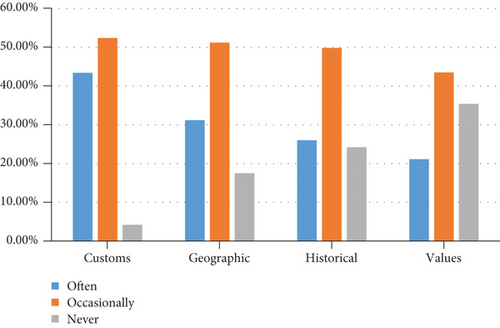
From the survey results in Figure 1, it is not difficult to see that the overall situation of English teachers teaching students the cultural knowledge from other countries is not very close to the reality, and it is difficult to impress people. However, it is worth confirming that the teachers’ understanding of students about foreign customs and Western thoughts is good, and the frequency of lectures is relatively high. The teaching of intercultural language knowledge by college English teachers is shown in Figure 2.
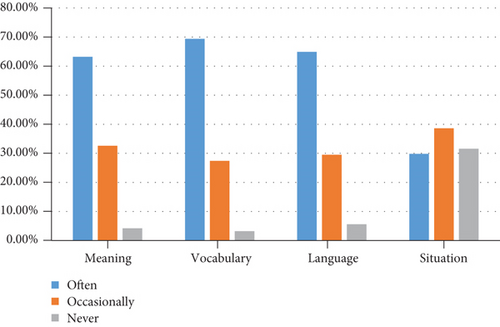
From the survey results in Figure 2, it is not difficult to see that teachers’ crosscultural language ability is relatively enough to enable students to understand the culture behind the language from multiple perspectives and clearly realize the importance of language ability. However, the existing problems are also more obvious: in language practice, teachers fail to simulate the context and communicative situation.
4.3. Cultivation of Crosscultural Communication Attitude in English Teaching
The main obstacle to students’ crosscultural communication is not only the language itself but also the understanding of the sociocultural background and personal attitudes of other countries. Students should be prepared to actively understand foreign cultures, actively explore the similarities and differences between different cultures, respect cultural diversity, and lay the foundation for successful crosscultural exchanges in the future. From the current situation of higher education in China, classroom teaching is not only the main channel for teachers to transfer knowledge but also a platform for students’ cognition of the outside world. The status of English teachers in cultivating students’ crosscultural communication attitude is shown in Figure 3.
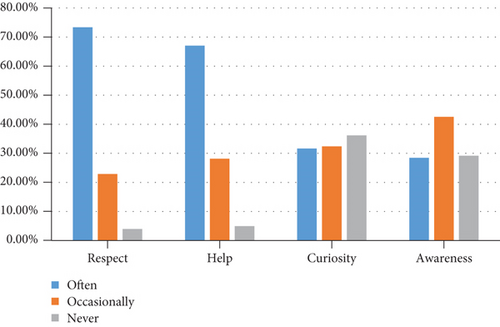
As can be seen from the data in Figure 3, although teachers are very good at cultivating students’ respect and understanding of foreign culture, they still lack the cultivation of communicative attitude, and the importance of cultivating crosscultural communication ability has not been recognized. In addition, many times, people cannot master all the communication knowledge; so, using communication strategies is particularly important. In the process of communication, we will inevitably encounter various difficulties. By choosing appropriate communication strategies, we can effectively avoid silence and embarrassment. The main place for college students to learn intercultural communication is the English classroom. Therefore, whether teachers teach English the necessary communication strategies in class will be the key to the improvement of students’ crosscultural communication ability. The development of intercultural communication strategies by English teachers is shown in Figure 4.
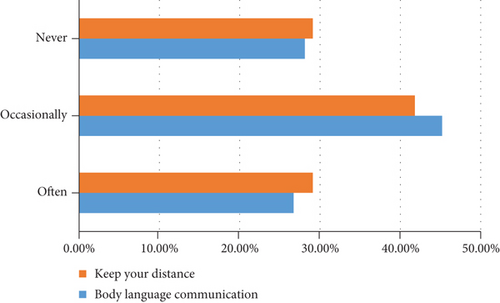
The survey results in Figure 4 show that teachers’ cultivation of students’ intercultural communication strategies is not enough. Although it is involved, they do not often teach intercultural communication strategies to students. The abscissa is a ratio, which represents a situation in which English teachers maintain distance and communicate with body language when they train students in crosscultural communication, that is, never, occasionally, and often.
4.4. TTPC Strategy Cultivation in the Crosscultural Communication competence of College Students
In order to verify the effect of face-to-face teaching through classroom experiments, we made the following research assumptions before the study: after the implementation of TTPC teaching strategy, the experimental classroom students’ crosscultural communication competence was significantly improved. It has improved after the learning test, which means that the application of TTPC learning strategy can enhance students’ crosscultural communication skills. Before the start of the experiment, we tested them using the crosscultural communicative competence rating scale and performed a descriptive statistical analysis of the statistics, as shown in Table 2.
| Class | The gift of tongues | Pragmatic ability | Strategy ability | Crosscultural knowledge | Crosscultural attitude |
|---|---|---|---|---|---|
| Number of people | 43 | 43 | 43 | 43 | 43 |
| Total points | 30 | 30 | 30 | 30 | 30 |
| Average | 13.76 | 12.83 | 17.24 | 15.18 | 19.69 |
| Scoring average | 39.2 | 42 | 68.96 | 65.63 | 70.9 |
| Standard error | 3.24 | 2.15 | 2.61 | 2.37 | 1.43 |
Table 2 shows that the scores for the six dimensions of crosscultural communication competence show that the average score of crosscultural attitudes was 19.69, the highest among the five dimensions, indicating one attitude of students’ favorable feelings towards crosscultural teaching. The norm is 1.43 poor compared to those in other countries, indicating that students’ long-standing desire for intercultural communication is common. Secondly, due to frequent exchanges and technological progress, students can master some crosscultural basic knowledge and dare to use it boldly in crosscultural communication. On this basis, we performed crosscultural communication ability tests, and a descriptive statistical analysis of the statistics is presented in Table 3.
| Class | The gift of tongues | Pragmatic ability | Strategy ability | Crosscultural knowledge | Crosscultural attitude |
|---|---|---|---|---|---|
| Number of people | 43 | 43 | 43 | 43 | 43 |
| Total points | 20 | 20 | 20 | 20 | 20 |
| Average | 10.07 | 10.04 | 12.02 | 11.44 | 14.64 |
| Scoring average | 50.85 | 55.2 | 45.6 | 55.65 | 49.2 |
| Standard error | 3.26 | 2.39 | 3.11 | 2.27 | 2.91 |
Table 3 shows that in the crosscultural situation test, the average of students’ five dimensions of crosscultural communication competence corresponds to the results of Table 2, and then the average scores and standard deviations of the two classes were compared as shown in Figure 5 (class 1 is the scale evaluation class, and class 2 is the situational test class).
Figure 5 The comparison results show that most of the students can show a positive attitude in the test, willing to actively communicate with foreign teachers and express their ideas and opinions. We should maintain this crosscultural exchange activity.
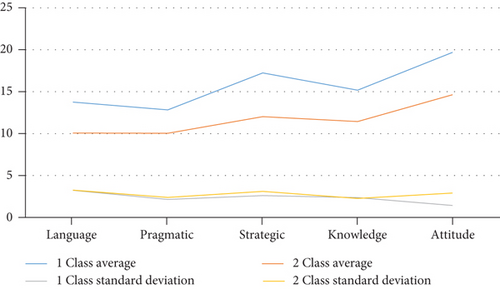
4.5. t-Test Analysis
After the classroom experiment, the author again used two research tools to evaluate the crosscultural communication competence of experimental classroom students from six dimensions: individual changes and overall classroom differences were analyzed by the SPSS paired t-test sampling method, see also Figures 6 and 7. The M value here refers to a measure of strategic ability, crosscultural attitude, language ability, crosscultural knowledge, and pragmatic ability, and the size of the M value represents the strength of ability.
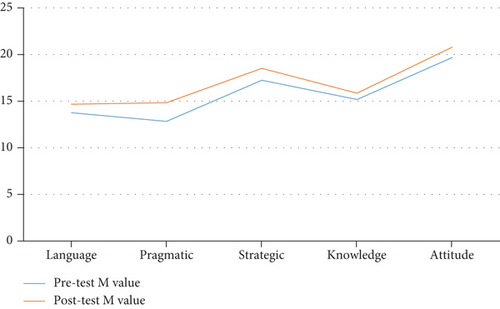
As can be seen from the comparison of data in Figure 6, there were very significant differences between crosscultural communication competence dimensions before and after the experiment, while there was no significant difference in crosscultural knowledge.
As can be seen from Figure 7, pragmatic abilities and crosscultural attitudes differ significantly before and after the experiment but not in language abilities and cross-cultural knowledge. Compared with the conclusion of Figure 6, it can be seen that the differences and changes in the various dimensions of crosscultural communication competence in Figure 7 are consistent with them in principle. Data on intercultural communication ability are now shown in Table 4.
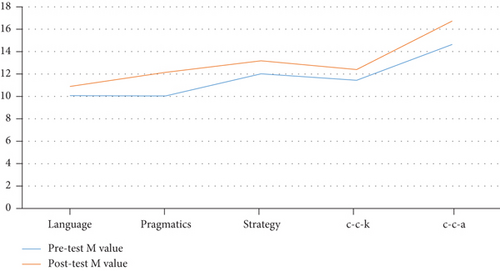
| Group | Average score of pretest | Posttest average score |
|---|---|---|
| Scale assessment class | 78.7 | 84.69 ∗ |
| Situational test class | 58.21 | 65.35 ∗ |
The results in Table 4 clearly indicate that the intercultural communication ability was measured using the teaching scale, and the situational test was significantly different from the pretest (P < 0.05). It can be concluded that through the experimental teaching of TTPC learning strategies, students’ crosscultural communication competence is significantly improved. In this article, ∗ means P < 0.05; that is, the crosscultural communication competence of the scale is significantly different from the previous one, and the ability has been greatly enhanced.
4.6. Application of Hierarchical Correlation Analysis in Teacher Curriculum
The factors influencing teachers’ curriculum design ability are divided into five dimensions: school system atmosphere, teaching materials, teachers’ attitude, teachers’ knowledge, and teachers’ ability to use teaching materials. We conducted a separate study of the College institutional atmosphere and obtained a total of 3 sets of data, as shown in Table 5.
| Curriculum design ability-school system atmosphere | Correlation (), γoi |
|---|---|
| Lesson preparation | 0.8542 |
| The number of lectures | 0.5610 |
| Training method | 0.8889 |
Table 5 shows that training methods are related to course design skills > degree of lesson preparation to course design skills > number of lectures to course design skills. In addition, hierarchical correlation analysis can also be applied to the correlation degree of the overall curriculum design ability and curriculum resource status, the overall curriculum design ability and teachers’ attitude, the overall curriculum design, the overall course design ability and curriculum resource utilization ability, and so on.
5. Conclusion
In today’s globalization, international exchanges are increasingly common, and crosscultural exchanges will inevitably encounter cultural differences and potential communication barriers. Therefore, in foreign exchange trading and communication, it is necessary to have certain crosscultural communication skills to ensure smooth and effective communication. Although intercultural communication and college English teaching belong to different fields, the common goal is to cultivate people with both intercultural communication skills. Language teaching eliminates the language barrier of crosscultural communication and lays the foundation for crosscultural communication through the coordinated evolution of language teaching. Crosscultural communication should make full use of foreign language teaching and organically combine crosscultural communication education with foreign language teaching to achieve a profitable situation. In the process of English teaching reform in higher education, we can see the significant changes in the continuous improvement of students’ English skills, but we must also objectively solve the problems existing in the current teaching mode. Change teaching methods, pay attention to language knowledge and skills, ignore cultural teaching, and ignore the input and output of local culture, teaching culture imbalance, lack of interoperability, teaching cooperation and communication, and indifferent communication skills. We need to think about phenomena and study and explore and test new teaching models. This paper discusses the methods of college English teaching and builds them based on the research and efforts to overcome the dilemma of language teaching. To study, exploring and developing crosscultural English teaching methods in universities are also a process of reflecting on the current foreign language teaching. However, due to the time and environmental conditions, the in-depth research and discussion cannot be conducted, the research and analysis of the model were more oriented to the students’ needs and the problems of the model itself, and the teachers failed to implement the model. Further practice and experimental demonstrations are needed, which also leaves room for further future research. I believe that under our common care and concern, Chinese university English teaching will gradually improve and achieve the ideal teaching goal of teachers. The future research focus of this research is on the research on the crosscultural knowledge system of English teaching, perfecting the deficiencies in the crosscultural teaching system, researching or revising the original knowledge system structure, and expanding the application scope of its knowledge system structure.
Conflicts of Interest
The author declares no conflicts of interest regarding this work.
Acknowledgments
This work was supported by the Research Project of Hunan Provincial Office of Education, China (Grant No. 2021352) and by the Research Project on Teaching Reform of Colleges and Universities in Hunan Province, China (Grant No. 2021298).
Open Research
Data Availability
The experimental data used to support the findings of this study are available from the corresponding author upon request.




